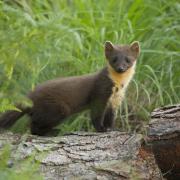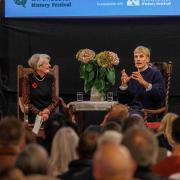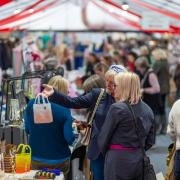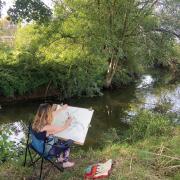Siân Ellis finds out how tree and hedge planting projects around the Cotswolds are benefiting nature, farming and the landscape
Who doesn’t love trees and hedgerows? They are certainly a special feature of the Cotswolds, painting the landscape with their seasonal colours and providing welcome habitat for wildlife. Now, more than ever, they are becoming an important focus of integrated land management and farming, too.
The spotlight is not simply on trees as part of woodland creation, but more inclusively on all sorts of canopy cover, says Scott Brown, Farming Engagement Lead for Cotswolds National Landscape (CNL). This can mean planting and restoring hedges or traditional orchards, shelterbelts, or groups of trees in parkland – to name just a few examples. ‘Trees outside woodland represent a really significant proportion of our tree cover in the Cotswolds.’
Scott has been meeting lots of land managers and farmers recently, discussing project applications for grants from the government’s Farming in Protected Landscapes (FiPL) programme, which is being delivered in the Cotswolds by CNL (see Cotswold Life, May 2022 issue). The scope of the grant programme is broad and includes support for beneficial, landscape-appropriate tree and hedge planting / restoration schemes.
‘Tree planting isn’t just about helping nature or helping the climate through carbon capture; it can be a really valuable part of the green infrastructure, helping to look after soils and provide shelter for livestock. It can be part of a system that provides woodchip or produce. There is huge potential for agroforestry to take off, including silvopasture [where trees are integrated into livestock grazing] and silvoarable systems [where rows of trees intersperse with wide alleys for cultivating crops].’
BEYOND THE HEDGE
Henry-James Gay is tenant of the Duchy of Cornwall’s 1,000-acre-plus organic mixed Broadfield Farm at Tetbury. He recently gained a FiPL grant towards dry stone wall restoration and some 500 metres of hedgelaying – there is a strong tradition of the latter at Broadfield including sections previously laid by King Charles, a noted practitioner of the ancient craft. ‘I’ve got a good standard to try and keep up to!’ Henry-James acknowledges; he is employing local experts for the work and hopes to learn the skills too.
The latest hedgelaying is part of a wider management system on the farm which allows hedges to grow up to provide habitat for wildlife and bird food, until at a certain height they need to be laid: encouraging fresh growth and regenerating the hedge.

‘Essentially we are trying to create a mosaic across the farm – of older, thicker hedges; hedges that have been allowed to grow taller; younger hedges – so that wherever we are on the farm there will always be some form of different habitat; so that we are not creating the monoculture that farming can be widely associated with.’
A range of species is used in the hedges, from blackthorn and hawthorn to spindleberry and hazel. In addition to the inherent stock-proof nature of spiky plants, many hedges have fences in front of them ‘to protect them from stock pushing their heads through and picking at them,’ Henry-James says.
Other initiatives aimed at encouraging wildlife on the farm include planting wildflower margins alongside hedges, and planting areas with winter bird food – a trial of the latter proved a huge success in providing cover and flowers for insects and bees last summer.

In recent times 300 to 400 trees a year have been planted at Broadfield, contributing (through carbon capture) to efforts to lower the farm’s carbon footprint, and providing shelter for animals in fields. In particular, walnut trees are being planted in strategic areas around the farm to help protect cows from bothersome flies and reduce the need for fly spray. ‘Walnut trees release a pheromone which deters flies from coming near them.’
Henry-James is also considering silvopasture: allowing cows to go into woodlands for shelter in summer.
‘We are custodians of the land and whatever we do is for future generations. I hope to make my time here as good as possible,’ he concludes.

FRUIT ’N’ NUT
Emma and Rob Harrison, sixth and third generation farmers respectively, received a FiPL grant to help them plant 100 fruit and nut trees at Greystone Farm at Blockley in the north Cotswolds, as part of a new agroforestry / silvopasture scheme.
The couple, who run an organic dairy herd, have planted their Twelve Acre field with two rows of apple trees, a row of nut trees, a row of willow and a row of mixed species – with a gap of 24 metres between each row. ‘So, we are still using it as a grass field to feed our dairy cows or produce silage from, with the added benefits that trees provide shade and shelter for the cows.
‘The grass growth beneath the trees tends to be better because the soil is healthier – there is a lot of science showing how trees talk to each other and work together, and their roots take up rain coming into the field and help with drainage. The trees provide important wildlife corridors too. We’ve planted a mix of apple varieties so that the blossom period in the field is quite long and benefits more insects and bees.’
Apples are turned into juice to sell in the farm shop.
While researching what nut trees to plant, Emma was astonished to discover a local expert ‘literally ten minutes away from me’. Following helpful discussions with Tom Tame of Warwickshire Walnuts & Trees, she planted walnuts – tall enough for the cattle to wander beneath and useful as fly deterrents. Coincidentally, Tom has gained a FiPL grant to run courses for people interested in setting up nut orchards and agroforestry systems; Emma is keen to attend to learn more for her ‘nut journey’.
Meanwhile tree planting at Greystone Farm continues. ‘I intend putting a different formation of trees in every single field, dealing with each individually according to its slope, aspect and predominant use, for arable or for grass. It’s not an exact science and time will tell what works best!’

COMMUNITY EFFORTS
Further tree-related projects supported by FiPL funding include a silvopastoral enterprise consisting of orchards grazed by sheep at Harescombe, and oak trees being planted as a nature-friendly ‘buffer’ between the busy A40 and surrounding countryside (without completely screening views for motorists).
There is plenty of (non-FiPL funded) community planting going on too. Ourboretum, the joint project between BBC Radio Gloucestershire and CNL launched in 2020, continues to plant out hazel, oak and beech saplings grown from seed / nuts by local people, to create a ‘virtual arboretum’ across Gloucestershire (bbc.co.uk/ourboretum). Recipient sites range from Gloucestershire Wildlife’s Severn Treescapes project to Greystone Farm.
Tree and hedgerow planting is regularly carried out by Cotswold Voluntary Wardens, and many councils and organisations have leafy schemes. Last winter, for example, the Feoffees of Tetbury invited locals to help plant 160 metres of hedgerow, using plants provided by the Woodland Trust, to encourage biodiversity in the Preston Park area.
‘For the love of trees’: look out for planting projects near you!
To find out more about FiPL visit cotswoldsaonb.org.uk or contact Scott Brown Scott.Brown@cotswoldsaonb.org.uk
Find out more about National Hedgerow Week here.



























